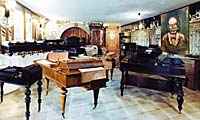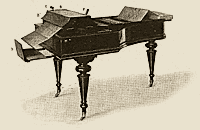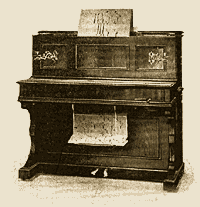|
     |
This small museum is
dedicated to Giovanni Racca, to his wonderful Piano Melodico as
well as to his numerous fantastic adaptations for cardboard books. The
Piano Melodico enjoyed extraordinary success from the very first
years of its manufacturing, towards the end of the nineteenth century,
up until 1920-25. Many wealthy and high-ranking people were impressed by
the beautiful shape of this instrument, its fascinating sound and by the
wide-ranging repertoire available, to the extent that as many as ten
thousand pieces were produced and sold throughout the world. Even kings
and queens were fascinated by it, for example the Italian Queen Mother
Margherita di Savoia, H.R.H. Princess Letizia and the Crown Prince
Danilo of Montenegro owned one. H.R.H. the Duke of Abruzzi, when
organising his expedition to the North Pole, asked to have a Racca
Piano Melodico on board the "Stella Polare".
|
Why was the work of
this artist from Bologna so successful? There are several reasons
for this. First of all because it is unique. Unlike the Cylinder
Musical Boxes, Player Pianos, Barrel Pianos and other instruments
produced by a large number of manufacturers, the Piano Melodico
was designed and patented by Giovanni Racca who was the only person
to manufacture it. While almost all manufacturers used the cylinder
with nails as musical support, in 1888 Racca was one of the first to
start his production using cardboard with holes and was thus able to
use a wide range of music scores. His instruments show exquisite
taste and the Grand model covered with walnut briarwood was worthy
of any royal palace or mansion. |
 |
His technique was
extremely refined, with a metal harp right from the beginning, precise
mechanisms as well as precious and skilfully worked wood.
The instrument had a
very large repertoire, both in its version with 48 and 73 notes, ranging
from:
waltz, polka, mazurka,
tarantella, lancers, quadrilles, galop, Scottish dancing,
gavotte, new dances, marches, anthems, songs, opera (the most extensive
section), comic opera, operettas, symphonies, concerts, fantasias,
theatre dances, oratorios, religious music, oriental music, Hungarian
songs, Dutch songs, Scottish songs, Slav songs, Indian songs, folk
dances, Spanish music, Russian music, Polish music, Hungarian music,
Bohemian music and much more.
|
 |
What is left of all
this in the world today? Very little because almost everything was lost
or destroyed which means that Racca does not occupy the position he
deserves in musical history. It should be mentioned that most of the
museums devoted to mechanical music all over the world own a Piano
Melodico with some musical scores, but apart from this nothing is
known about the range of his instruments and music - it is as if a cloud
of mystery concealed Racca and his work. |
This museum is
completely dedicated to him and contains an incredible amount of
unpublished documents, as well as about a thousand original pieces of
music and twenty instruments.
The documents range
from his birth certificate, the family tree from 1700 to the present day
including family members who are still alive today (and unaware of their
famous ancestor), the 1886 patent which was recently recovered, photos
of Racca and his family, of the company. There is a copy of the first
exhibition at the International Music Fair in Bologna in 1888 as well as
advertising material, booklets illustrating the various Piano
Melodico models, its music … and much more.
|
The more than one
thousand pieces of music consist of:
-
about twenty music "rolls" of the very
first series (to our knowledge these are found in no other museum)
signed by Giovanni Racca
-
a few dozen "prototypes", i.e. the first
piece of music created starting from a white sheet of paper and drawn by
hand
-
several hundred "master" music books, that
is to say the originals used by the factory to produce copies for sale
-
the rest is divided between the 48 and
73-note model and the Verdi, the electric vertical model or with
counterweight with two extra holes for "automatic expression"
-
music with dedication from the author to
Queen Margherita dating back to February 1908.
|
 |
|
The instruments, about
twenty of them, are undoubtedly the widest range available: they go from
the first 48-note model working with cardboard rolls, found in no other
museum, to unique models created for exhibitions, to the desktop models,
small and large grand models, coin-operated Verdi., Vorsetzer or
mechanical fingers, Harmoniums, all the way to an absolutely
unusual-looking Barrel Piano.
The museum has been
visited by a US delegation associated with the MBSI guided by its
chairman, as well as by the most esteemed and renowned collectors or
owners from museums in and outside Europe.
The town of Longiano
has dedicated a square to Giovanni Racca. |
|




